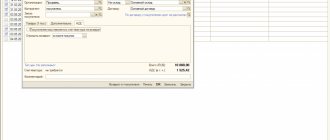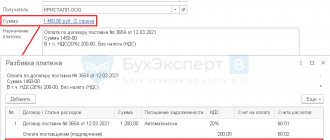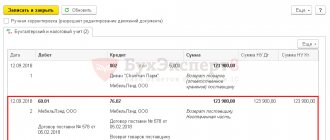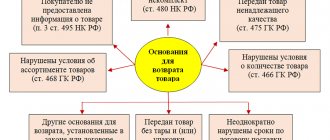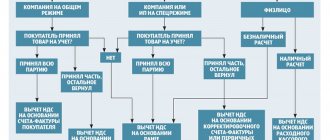Return of goods in 2020-2021
So, from 2021, VAT when returning goods to the supplier is required to be processed according to the following rules:
- The seller prepares an adjustment invoice and records it in the purchase ledger.
- The buyer no longer draws up an invoice, but registers the seller’s adjustment invoice in the sales book (if he managed to accept VAT for deduction, if not, then he accepts the deduction in the non-refundable part).
It does not matter for what reason the return occurs. This is how the return of both defective and high-quality goods is processed if it does not comply with the contract. If you issue a return with an invoice from the buyer (as was done previously, until 2021), the seller will lose the VAT deduction. The same procedure applies if the buyer does not pay VAT due to the use of a special regime (USN, UTII).
ConsultantPlus experts spoke about VAT deductions from the seller when returning goods. Study the material by getting trial access to the K+ system for free.
Such clarifications are provided by the Ministry of Finance (you can view the details of the letters using the links above). But at the same time, he makes the following addition: if the goods are returned under a purchase and sale agreement, where the parties change places, invoices are issued as for sales (see, for example, letters of the Ministry of Finance dated May 15, 2019 No. 03-07-09/34582, No. 03-07-09/34591).
Read more about issuing return invoices in this article.
When the return will be a reverse implementation
As a rule, when returning goods, no one enters into a separate purchase and sale agreement, in which the buyer becomes the seller and the seller becomes the buyer. Therefore, it is not easy to immediately imagine the situation that the Ministry of Finance is talking about.
But even if there is no such agreement, reverse implementation may occur. Look carefully at the original contract. Does it contain a condition on the repurchase of goods by the seller? For example, if the buyer was unable to sell them before a certain time. This is the reverse implementation, in which the buyer must create an invoice.
The next point is important here. To avoid claims for deduction, the contract should clearly state that the return of the goods is carried out by return delivery, in which the buyer is the seller and the seller is the buyer. Then the inspectors will have no reason to find fault with the invoice (it will not be an adjustment, but a regular one). If there is no such specificity in the contract, claims are possible against any execution of the transaction:
- You made an adjustment invoice, and the tax office says: “You have a buyback, you need an invoice from the buyer” - and removes the deduction.
- Or, on the contrary, you have issued a return delivery, and the controllers tell you: “You don’t have anything written about return delivery, it says about a return” - and you also lose your deduction and are forced to go to court.
So review your contracts and make changes if necessary.
By the way, buyback is possible not only for unsold quality goods, but also for defective ones (letters from the Ministry of Finance dated May 15, 2019 No. 03-07-09/34582, No. 03-07-09/34591).
Repurchase
Buyback is a type of agreement where the buyer of a certain item undertakes to return the same item to the seller upon request. The main purpose of the agreement is for the owner of the thing to receive more profit than he could have if he pledged it. In addition, unlike collateral, the owner retains the right to possess the asset.
Repurchase is a modern repo transaction, which is used by the Central Banks of various countries as a powerful tool of monetary policy. Repo (repurchase) transactions are also used by traders for whom such operations are an excellent opportunity to make money.
Repurchase (repo transaction) is an agreement between two parties. Under the terms of the concluded transaction, one of the parties undertakes to sell a financial asset to the other party, and then (after some time) buy it back. The repurchase date is usually agreed upon in advance.
Buyback: history, law, essence
The essence of the repurchase agreement has almost nothing in common with the modern provisions on civil transactions, which require a strong legal basis and certainty for each of the parties in their rights. The owner of an item, who can lose it at any time at the request of the original seller, puts the real holder in a difficult position. This is especially true when it comes to further relationships between the buyer and third parties.
Repurchase agreements often involve abuse by the participants. One of these is covering up types of security prohibited by law with a transaction. Therefore, repurchase agreements have certain limitations. Thus, in every right regarding repurchase there were (in some and still exist to this day) the following prohibitions:
— French law prohibits the execution of a repurchase agreement for a period of more than 5 years. When purchasing real estate and knowing a third buyer, a repurchase is equivalent to a repurchase procedure;
— in general German law, the duration of the contract is reduced to 3 years. The only exception is real estate transactions, for which the transaction period can be up to 30 years;
- according to Baltic law. If the validity period is not specified in the agreement, then the repurchase does not have a statute of limitations;
- according to the Roman constitution, repurchase (as opposed to the more common repurchase in rem) has only a mandatory effect. This means that the right of repurchase can only be exercised against the original counterparty, and not against a third party to whom the thing was transferred.
The cost of the repurchase (unless otherwise specified in the agreement) is the cost of the original transaction, taking into account the amounts that the repurchase buyer undertakes to cover to the seller for expenses incurred. At the same time, Baltic law allows participants to independently set prices. If an agreement cannot be reached, the price is determined by the court.
Under French law, the selling party in a repurchase transaction can expect to cover current costs, as well as those resulting from an increase in price.
According to general German law, the seller in a repurchase transaction must remove all harmful devices from the property. In another situation, he is responsible for the decrease in the value of the product and the damage caused to it. If the repurchase agreement exists at the original price, then neither a decrease nor an increase in the price of the property allows the parties to the transaction the right to compensate for losses. In this case, collection of interest payments on the original (purchase) cost for the period from the first repurchase is not allowed.
At the present stage, a repurchase agreement is an agreement under which one party sells an asset and at the same time (as part of a promise or other agreement) undertakes to repurchase it. Alternatively, a party may obtain a repurchase option. The role of the object that is subject to redemption can be played by:
- an asset that acted as an object and was sold during the initial transaction; — similar asset; - another asset, the element of which is the asset sold in the first transaction.
Repurchase: forms, features, advantages
In modern practice, repurchase can take the following forms:
— the company’s obligation to buy the transaction object (asset) back. Such a transaction is called a forward; — the company’s right to buy the transaction object back (call option); — the obligation of the enterprise to buy back the object of the transaction (asset) in the event of a request from the buyer (put option).
In addition, repo transactions are increasingly in demand on the Russian market - repurchase agreements that allow lenders to reduce current risks and borrowers to receive money on favorable terms.
The essence of modern repurchase operations (REPO) is as follows:
1. At the first stage, one party sells to the other an asset (most often a security) with the condition of repurchase in the future. At the same time, it is stipulated that the same number of securities will be purchased at a certain price.
2. At the second stage, the assets are repurchased under the terms agreed upon by the parties.
The repurchase agreement itself is a transaction involving a repurchase, namely the initial sale of an asset followed by its subsequent repurchase. The main purpose of the transaction is not the purchase (sale) of an object, but the temporary transfer of cash to the seller for the right to use any asset.
In practice, the initial cost of the asset when performing a reverse transaction is lower than the cost of repurchase. Essentially, the seller is the borrower, and the buyer is the lender. The latter, in turn, can count on a refund taking into account accrued interest. There are cases when a repurchase is made under different conditions, that is, the cost of the initial sale of the asset is higher than the repurchase price. In this situation, the seller acts as a lender, providing the necessary funds to the buyer. The object of the transaction itself acts as a kind of collateral.
The spread (difference) between two prices (buy and sell) is called the interest on the repurchase transaction (REPO). In the first case, this is an interest payment on a monetary loan, and in the second, an interest payment on a loan in the form of property. In the practical field of activity, the object of repurchase is securities. There are several reasons for this:
— turnover on the sale of securities (unlike the sale of other types of assets) is exempt from taxes;
— registration of the purchase and sale of bearer securities from a legal position looks much simpler (in comparison with the future purchase and sale of certain types of property). For example, in order to register a property for sale, it is necessary to confirm the seller’s ownership of the property. In a repo transaction, this is difficult to implement, because the essence of the operation is the repurchase of real estate by the original owner and subsequent sale by a company that, at the conclusion of the transaction, does not belong to the category of owners of the property;
— securities have great liquidity, therefore they are most attractive to the buyer (creditor).
Repurchase (repo) transactions have many advantages. First of all, this is convenient for the lender, who not only receives the object of the transaction as collateral, but becomes its full owner. Consequently, if the seller refuses to return the object of the transaction through repurchase, then the creditor has a chance to sell the asset at the market price without any additional approval from the debtor. In this case, all costs will be covered from the funds received. An important advantage is that the lender does not need to check the liquidity and solvency of the other party, because he has in his hands a liquid product that, in fact, was purchased.
On the other hand, the lender still risks due to the likelihood of a decrease in the liquidity of the received transaction object. There is one more important point. When carrying out a repurchase, the buyer is freed from many verification procedures of the seller (borrower), and the borrower loses the benefits of using the collateral (for example, the right to receive dividend payments). For this reason, rates on repurchase agreements are typically less than those on standard secured agreements.
Another advantage of the operation is that those persons who, for various reasons, do not meet the requirements of a banking institution can count on receiving a loan. The main thing when making such a transaction is to have liquid property on hand.
An important point is taxation when making such transactions. Thus, the Tax Code of the Russian Federation stipulates a special procedure for collecting taxes from repurchase transactions (REPO). This process has certain differences from the usual procedure for taxing expenses and income in the process of purchasing securities.
However, the special form of settlement applies only to transactions involving securities. As for, for example, the sale and repurchase of bills of exchange, general rules apply here. In addition, special rules do not apply if the buyback does not take place or the second part of the transaction is not completed.
Return of goods: difference in accounting
The differences between a return and a buyback are also important for reflecting the transaction in accounting.
Regular return
When returning goods that have been accepted for registration, the buyer will make the following entries:
- Dt 76 (not 62!) Kt 41 - for the cost of return;
- Dt 76 Kt 68 - for the amount of VAT on the adjustment invoice.
The seller must reverse:
- revenue: Dt 62 Kt 90;
- cost: Dt 90 Kt 41;
- VAT: Dt 90 Kt 68.
Buyback
The buyer reflects the sale of goods:
- Dt 62 Kt 90 - for the redemption amount including VAT;
- Dt 90 Kt 41 - for the cost of returned goods;
- Dt 90 Kt 68 - for the amount of VAT.
The seller, accordingly, enters these goods into his account:
- Dt 41 Kt 60 - for the cost of return (redemption);
- Dt 19 Kt 60 - for the amount of VAT;
- Dt 68 Kt 19 - VAT deductible.
How to return payment
In the event that the current buyer has already fully returned material assets to the seller, the supplier is obliged to transfer the agreed amount of money to the client’s account. The amount of compensation may be the same as for the original payment for services. It is also allowed to reduce/increase the cost of goods, but only by mutual agreement. Additionally, it must be taken into account that the seller has the right to retain a small part of the money in order to cover expenses incurred. The loss of possible benefits is not considered when calculating the cost of the product upon repurchase.
Also on the topic: Requirements have been developed for the formation of lots when purchasing medicines for medical use in accordance with Law No. 44-FZ
Additionally, the seller may retain part of the amount to cover the costs of repairs/purchase of damaged items. For example, this applies to vegetables and fruits, which have a very short shelf life.
Results
The procedure for processing the return of goods to the supplier has changed since 2019 and is now uniform: the supplier draws up an adjustment invoice, and the buyer only draws up an invoice marked “return of goods.” The buyer does not issue an invoice for the return. Based on the adjustment invoice, the seller accepts VAT for deduction during the period of return of goods, and the buyer recovers the VAT.
For a sample of filling out a correction invoice for returning goods to a supplier, see here.
Sources:
- Tax Code of the Russian Federation
- Decree of the Government of the Russian Federation dated December 26, 2011 No. 1137
You can find more complete information on the topic in ConsultantPlus. Free trial access to the system for 2 days.
